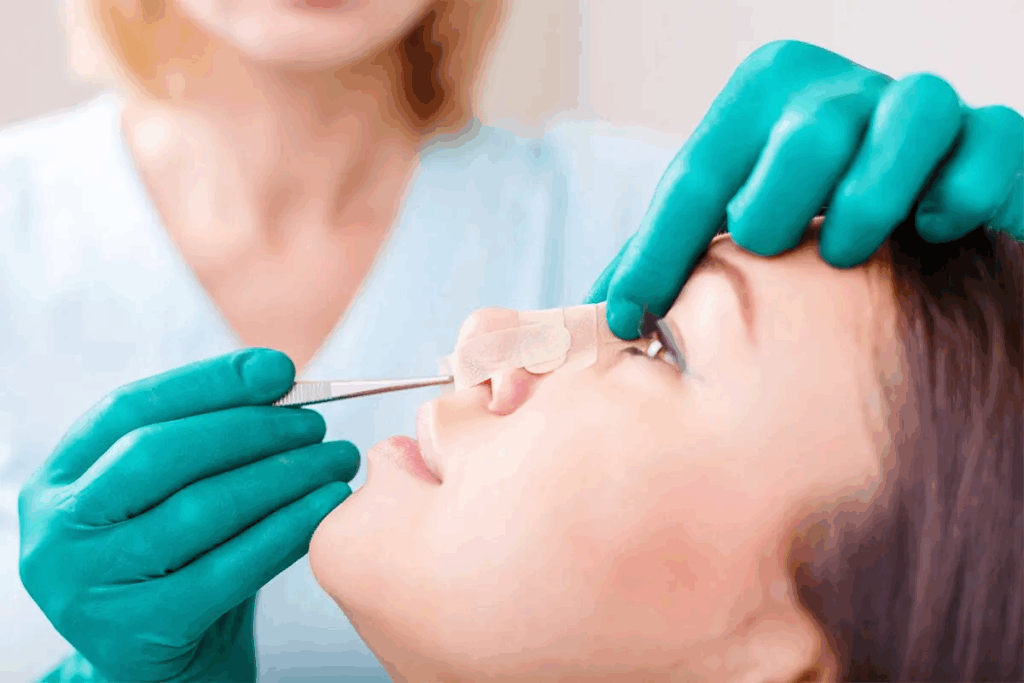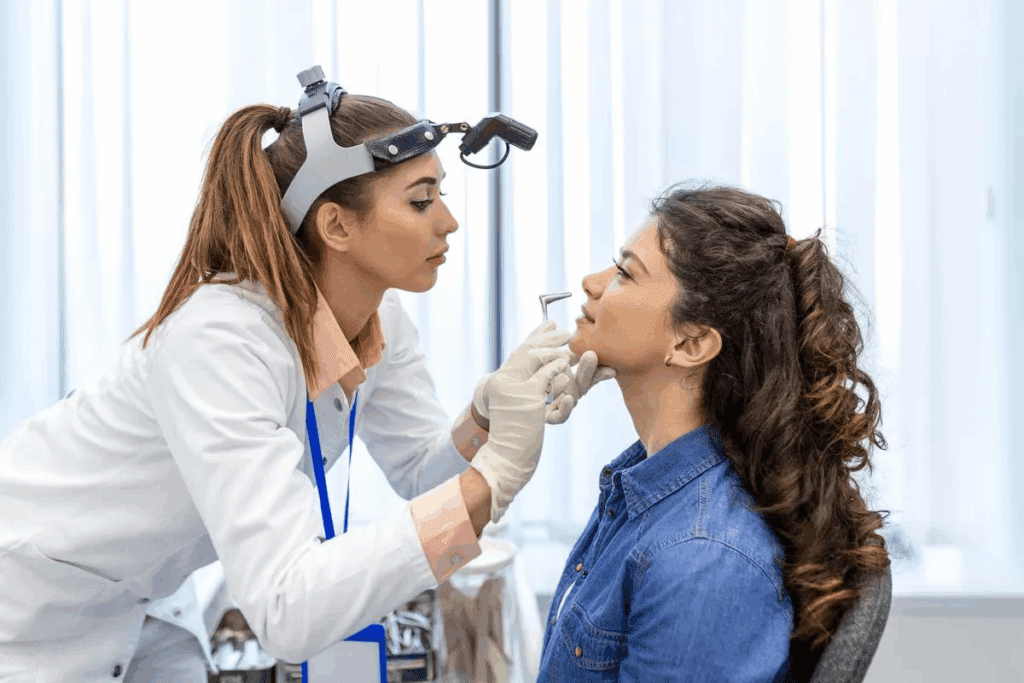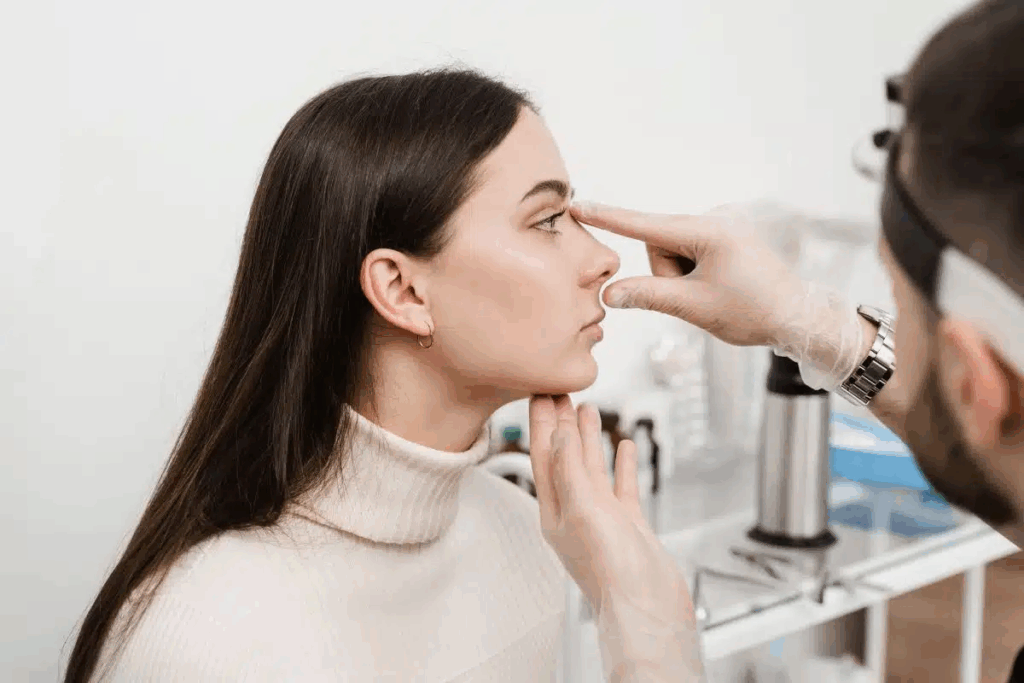
A deviated nasal septum happens when the thin wall between the nasal passages is off-center. This can cause breathing problems, affect sleep, and lower your quality of life. A guide to deviated nasal septum treatments, ranging from conservative management (medication) to definitive septoplasty surgery.
The Cleveland Clinic says a deviated septum occurs when the nasal divider is not straight. Some people are born with it, while others get it from injuries. Over 70 percent of people have some degree of this issue.
There are many treatment options available. These range from simple medical care to complex surgeries. Places like Liv Hospital use proven methods to help people feel better.

A deviated nasal septum is when the thin wall between the nasal passages is off-center. This makes one passage smaller than the other. It can cause breathing problems and discomfort.
The nasal septum is a thin wall made of bone and cartilage. It divides the nasal passages into two sides. It’s important for airflow and nasal health.
Nasal septum deviation can happen on either side. The severity of the deviation affects the symptoms.
A deviated nasal septum can be from birth or a nose injury. Genetic or intrauterine conditions can cause it during development.
Nose injuries, like from sports or accidents, can also cause a deviated septum. The impact can displace the delicate nasal structures.
Cause | Description | Potential Impact |
Congenital Condition | Present at birth, often due to genetic or intrauterine factors | Nasal obstruction, sinusitis |
Nasal Trauma | Injury to the nose, potentially causing displacement | Nasal septum deviation, breathing difficulties |
Developmental Factors | Growth and development issues during childhood and adolescence | Asymptomatic or mild symptoms |
Knowing how a deviated nasal septum develops is key to treatment. Whether it’s from birth or injury, understanding the cause helps in choosing the right care.

Many people have a deviated nasal septum without knowing it. This condition is quite common, affecting a big part of the world’s population.
The American Academy of Otolaryngology — Head and Neck Surgery found that deviated septum rates vary. They range from 31 to 65 percent. This wide range comes from different ways studies classify severity.
Recent studies show over 70 percent of people might have some nasal septum deviation. Several factors can influence these rates. These include genetics, environment, and other nasal conditions.
For example, a mild deviation of nasal septum to left or rightward nasal septal deviation might be more common in some groups. This is because of differences in anatomy.
The severity of a deviated nasal septum is judged by how much it affects the nose. Criteria include how much it blocks the nose, symptoms like discharge or loss of smell, and its impact on life quality.
A slightly deviated septum might not cause big problems. But more severe cases can lead to serious nasal blockage and other issues. Knowing these criteria helps doctors choose the right treatment.
We will look into the effects of these statistics and treatment options in the next parts.
Knowing the signs of a deviated nasal septum is key to getting better. This condition can make life harder by causing many symptoms.
The main symptom is nasal obstruction. It can block one or both sides of the nose. This makes breathing through the nose hard.
When the nasal septum is deviated to the right, airflow is not even. This can cause problems.
There are other symptoms too. These include:
These symptoms can really mess up your day. They cause discomfort and disrupt your routine.
Ignoring a deviated nasal septum can lead to bigger problems. For example, it can cause sleep disorders like sleep apnea. It can also make breathing issues like asthma worse.
When the septum is crooked or the nasal bone is crooked, it can affect how your nose looks. This can make you feel self-conscious or upset.
It’s important to understand these symptoms and possible complications. This way, you can get the right medical help. Recognizing the signs of a deviated nasal septum is the first step to feeling better.
To figure out if someone has a deviated nasal septum, doctors use different methods. They start with a detailed physical check-up.
A physical check is key to spotting a deviated nasal septum. Doctors use a bright light to peek inside the nose. This lets them see how the nasal septum is placed and if it’s off track.
They might also use a nasal speculum to open the nostrils. This lets them see more clearly inside the nose. It helps them understand how big the deviation is.
Even with a physical check, more tests might be needed. A CT scan can give detailed pictures of the nasal passages and sinuses. This helps doctors see more clearly.
Doctors might also use nasal endoscopy. This involves putting a tube with a camera into the nose. It lets them see inside the nasal cavity in detail. This helps find any blockages or infections related to the deviated septum.
The choice of tests depends on how bad the symptoms are and if there are complications. The tests help doctors plan the best treatment for each patient.
Diagnostic Method | Description | Use in Diagnosing Deviated Nasal Septum |
Physical Examination | Visual inspection using a bright light and possibly a nasal speculum | Initial assessment of nasal septum deviation |
CT Scan | Imaging study providing detailed views of nasal passages and sinuses | Assessing the extent of deviation and related complications |
Nasal Endoscopy | Insertion of a tube with a camera to examine the nasal cavity | Detailed examination of nasal passages and identification of complications |
A deviated nasal septum can really affect your life. It’s important to know when you need to see a doctor. Some people might just have a little problem, but others could have serious issues like blocked noses or infections.
Knowing the warning signs is key. The Mayo Clinic says if your nostril is always blocked, you get nosebleeds a lot, or have other bad symptoms, you should see a doctor. Other signs to watch for include:
Seeing these signs early can help avoid bigger problems and get better treatment. If you notice any of these, it’s time to talk to a doctor.
Finding the right doctor for a deviated nasal septum is important. An ENT (Ear, Nose, and Throat) specialist, or otolaryngologist, is the best choice. They know how to handle nasal septum and sinus problems.
To find an ENT specialist, you can:
Choosing the right specialist is a big deal for your treatment. An experienced ENT specialist can give you the care you need.
“The key to effective treatment is timely intervention. By recognizing the warning signs and seeking medical attention from the right specialist, individuals with a deviated nasal septum can significantly improve their quality of life.”
There are many non-surgical ways to treat a deviated nasal septum. These options depend on how severe the condition is. For mild to moderate cases, doctors might suggest non-surgical treatments to ease symptoms and improve life quality.
Several medicines can help with a deviated nasal septum. Cleveland Clinic says these drugs can make breathing easier by reducing swelling in the nose. Here are some treatments:
Always talk to a doctor before starting any medication. They can help you understand any side effects and find the best treatment.
There are also non-medication ways to manage a deviated nasal septum. These include:
These methods can be used alone or with medication for better results.
Treatment Option | Description | Benefits |
Decongestants | Reduce nasal congestion by narrowing blood vessels. | Quick relief from congestion. |
Antihistamines | Alleviate allergy symptoms contributing to congestion. | Effective for allergy-related congestion. |
Nasal Steroid Sprays | Reduce inflammation and swelling. | Long-term reduction in nasal congestion. |
Saline Rinses | Clear mucus and reduce congestion. | Non-medicated, safe for long-term use. |
If other treatments don’t work, surgery can help with a deviated septum. There are many surgical options, each one chosen based on the person’s needs.
Septoplasty is seen as the best surgery for a deviated nasal septum. The Mayo Clinic says it straightens and moves the septum to better airflow.
Key aspects of septoplasty include:
Endoscopic septoplasty uses an endoscope to see the septum during surgery. This method is more precise and less invasive.
The benefits of endoscopic techniques include:
Septorhinoplasty is a mix of septoplasty and rhinoplasty. It tackles both breathing problems and looks of the nose. This is good for those with breathing issues and want to improve their nose’s look.
Procedure | Functional Benefit | Aesthetic Benefit |
Septoplasty | Improves breathing | No aesthetic change |
Septorhinoplasty | Improves breathing | Can improve nasal aesthetics |
Rhinoplasty | No functional change | Improves nasal aesthetics |
There are many surgical options for a deviated nasal septum, from septoplasty to septorhinoplasty. Each case is different, and the right surgery depends on what a doctor recommends.
Getting ready for septoplasty involves many steps. It starts with detailed pre-surgery talks and checks. Knowing what to do can make you feel less nervous and help you heal faster.
First, talk to your doctor, who might send you to an ear, nose, and throat (ENT) specialist. The Mayo Clinic says this first meeting is key. It helps figure out how bad your deviated septum is and what to do next.
At your meeting with the ENT specialist, you’ll get a full check-up. This includes:
Before septoplasty, there are things you should know. Your doctor will tell you what to do. This might include:
Pre-surgery tests might also be needed. These check if you’re healthy enough for surgery. Your doctor will decide what tests you need.
There are more things you can do to make your recovery easier:
By preparing well for septoplasty, you can improve your surgery’s success and lower the chance of problems. It’s all about paying attention to details and following your doctor’s advice.
Understanding the recovery after septoplasty is key for a smooth healing. The process includes immediate care, long-term recovery, and managing complications.
Immediate care after septoplasty is vital for a good recovery. Patients must follow their doctor’s instructions closely. This may include:
The Cleveland Clinic notes that nasal congestion and discharge are common in the first phase of recovery.
The recovery time after septoplasty varies. Most patients see big improvements in 1-3 months. But, it can take up to 6-12 months for all swelling to go away.
Recovery Stage | Timeline | Expected Outcomes |
Initial Recovery | 1-2 weeks | Reduction in nasal congestion, improvement in breathing |
Intermediate Recovery | 1-3 months | Significant improvement in nasal function, reduction in swelling |
Full Recovery | 6-12 months | Complete resolution of swelling, optimal nasal function |
Septoplasty is usually safe, but complications like infection, bleeding, or septal perforation can happen. Knowing the signs and getting help fast is important.
By following care instructions and staying informed, patients can avoid complications and get the best results from septoplasty.
Choosing the right treatment for a deviated nasal septum is key to your quality of life. There are many options, and knowing the differences is vital for making a good choice.
Several factors influence your treatment choice. These include the severity of your septum deviation, your health, and what you prefer.
Let’s look at a comparison table to see how treatments differ:
Treatment Option | Description | Recovery Time | Potential Risks |
Septoplasty | Surgical correction of the nasal septum | 1-2 weeks | Bleeding, infection, septal perforation |
Turbinate Reduction | Reducing the size of turbinate bones | 1-3 days | Nasal dryness, crusting |
Nasal Decongestants | Medications to reduce nasal congestion | None | Rebound congestion, insomnia |
Talking openly with your healthcare provider is essential. Here are some questions to ask:
By thinking about these factors and asking the right questions, you can choose a treatment that fits your needs and preferences.
Understanding and treating a deviated nasal septum is key to feeling better. We’ve looked at what it is, why it happens, its symptoms, how it’s diagnosed, and how it’s treated.
A deviated nasal septum can block your nose, making it hard to breathe. It can also cause nasal discharge and other issues. Getting a proper diagnosis is the first step to finding the right treatment.
There are many ways to treat a deviated nasal septum. You can try non-surgical methods like medicines or nasal strips. Or, you might need surgery like septoplasty or septorhinoplasty. The best treatment depends on how bad the deviation is and what you need.
In short, a deviated nasal septum is a common issue that needs the right care. Knowing your treatment options helps you make better choices. This can improve your breathing and overall health. If you’re dealing with symptoms, don’t wait to see a doctor. They can help manage your condition effectively.
A deviated nasal septum is when the thin wall between the nasal passages is crooked. This can block breathing and cause other problems.
The main symptom is trouble breathing through the nose. It can also lead to sinus infections, nosebleeds, and a loss of smell. These issues can become chronic.
To diagnose, a doctor will do a physical exam and might use a nasal endoscope. They might also do a CT scan to see how bad it is.
Non-surgical treatments include medicines like decongestants and nasal sprays. You can also try nasal strips to help breathe better.
Septoplasty is a surgery to fix a deviated nasal septum. It’s the most common surgery. Other options include endoscopic septoplasty and septorhinoplasty, which also fixes cosmetic issues.
Before surgery, you’ll have a consultation and stop certain medicines. You’ll also need to plan for aftercare. Knowing what to expect during recovery is important.
Right after surgery, you’ll need to manage pain and swelling. The recovery takes time. It’s also important to know about possible complications and how to handle them.
Some cases are born with it, but injuries can also cause it. Avoiding nose injuries can help prevent it.
Choosing depends on how bad your symptoms are and how crooked the septum is. Talking to an ENT specialist is key to making the right choice.
Ask about how bad your case is, the risks and benefits of treatments, what to expect during recovery, and any possible long-term issues.
Subscribe to our e-newsletter to stay informed about the latest innovations in the world of health and exclusive offers!
WhatsApp us